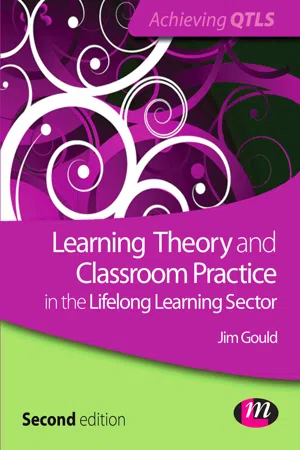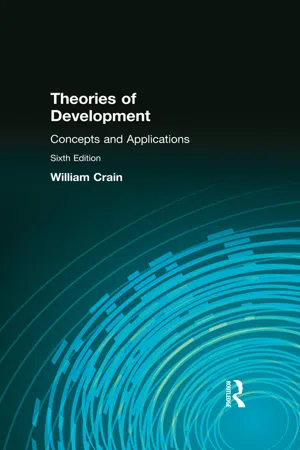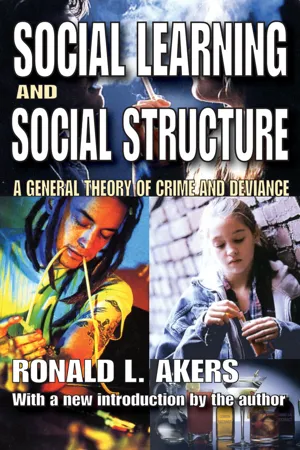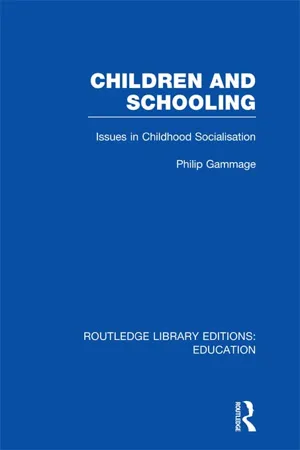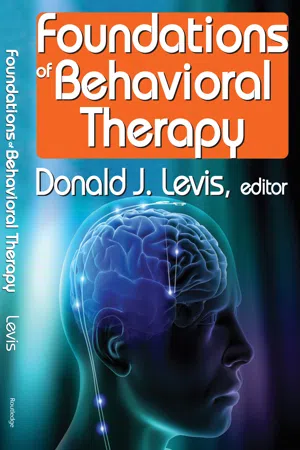Psychology
Social Learning Theory
Social Learning Theory, proposed by Albert Bandura, suggests that people learn through observing others and modeling their behavior. It emphasizes the role of social interactions and the influence of the environment on individual learning and development. This theory highlights the importance of cognitive processes, such as attention, retention, and motivation, in shaping behavior.
Written by Perlego with AI-assistance
Related key terms
Related key terms
1 of 4
Related key terms
1 of 3
12 Key excerpts on "Social Learning Theory"
- eBook - ePub
- Darrell S. Rudmann(Author)
- 2017(Publication Date)
- SAGE Publications, Inc(Publisher)
Social learning theory (Miller & Dollard, 1941; sometimes known as the “social cognitive theory” of learning (see Aronson, Wilson, & Akert, 2012; Bandura, 1986). Social Learning Theory focuses on the individual’s specific behaviors and the environment as does operant conditioning; but it includes cognitive and personal factors that interact as well (Schunk, 1991), including how people learn from watching others, what motivates people, and their beliefs about their own abilities. The tenets of social learning theory provided principles that bridged older behaviorist learning theories with the more contemporary theories researchers investigate today (Bandura, 1986; Rosenthal & Bandura, 1978).Figure 5.1 Quadrant of four perspectives on learningThe basic tenets of Social Learning Theory expressed a view beyond the pure stimulus-response-consequence learning of the past. As you might guess, Social Learning Theory asserts that someone can learn by observing others and watching the outcome that they receive. This doesn’t fit neatly into the trial-error learning that Thorndike employed, or operant conditioning, which posits that all learning is due to directly experienced consequences. Perhaps surprisingly, Thorndike himself did not see the learning of associations’ stimuli and responses to be a complete accounting of learning. In his writings on education, he emphasized issues of fatigue, personality, attitudes, interests, and even culture as influencing the learning process (Joncich, 1968). He saw his experimental work as a scientific attempt to turn the application of psychology to learning.Early social learning theorists had noted that some learning occurred without any behavioral change at all. Learners can collect observations that are put to use at a later time, a phenomenon called latent learning - Jim Gould(Author)
- 2012(Publication Date)
- Learning Matters(Publisher)
You will see Bandura’s work referred to both as ‘social learning’ and ‘social cognitive learning’. The boundary between these two categories is not that clear-cut. Bandura tried to present a balanced view showing that both behaviourist and cognitive theories impact on our learning but the active nature of the learning that takes place along with the role played by internal mental and decision-making processes within his approach, suggest that ‘social cognitive learning’ is probably the most apt descriptor. Certainly it is an active form of learning. Regardless of title, however, the main characteristics of Bandura’s theory can be summarised as follows.- People learn by observing others but as this is not through their own direct experiences, the process is known as vicarious learning.
- This learning can modify behaviour, but people do not always choose to apply what they have learned depending upon the consequences, actual or perceived, of that behaviour.
- People are more likely to adopt the behaviours modelled by someone they hold in high esteem or can identify with.
- The ability to learn is directly affected by the degree of self-efficacy that a person possesses.
Bandura and life
REFLECTIVE TASK
While we may want to use it in a deliberate manner in a learning environment, social learning has a significant but less overt effect on our daily lives. What examples of this can you identify?The development of phobias may well be related to social learning. If, for instance, a parent reacts badly to a spider, this could provide a model for a child to follow. As well as phobias, many of our attitudes are developed in childhood and these are heavily influenced by the behaviours modelled by parents and other family members. Attitudes such as those towards race, religion, gender, authority, money – the list is fairly endless – will be modelled in complementary live, verbal and symbolic modes on a regular basis with the possibility of direct as well as vicarious consequences for either adopting or not adopting these behaviours. Similarly, friends can also be powerful models as exemplified by the power exerted through peer pressure. In order to belong to a particular group, we exhibit the behaviours which are common within the group and which are approved of by the group as a whole. A similar argument can be applied to the clothes we wear, the shops we frequent or even the type of car that we drive. Advertising relies heavily on the principles underpinning Social Learning Theory in order to influence our behaviours and often targets specific demographic groups for this purpose. Not all social learning leads to desirable behaviours, however, as was seen in the Bobo doll experiments. We are often aware of the inappropriateness of our actions as role models and if not are subject to warnings of ‘not in front of the children’ when we overstep the mark. The media provides a significant source of behaviour modelling and a need to safeguard children from inappropriate role models led to the introduction of the television watershed which deems that material regarded as unsuitable for young children should not be broadcast before 21:00 or after 05:30 largely because of modelling relating to sex, violence and the use of strong language. Inappropriate modelling encompasses health and safety risks as well as behaviours that might be considered as morally unacceptable. Game shows and sports programmes which include dangerous or high risk activities often conclude with the advice not to ‘try this at home’.- eBook - ePub
Media Effects
Advances in Theory and Research
- Mary Beth Oliver, Arthur A. Raney, Jennings Bryant, Mary Beth Oliver, Arthur A. Raney, Jennings Bryant(Authors)
- 2019(Publication Date)
- Routledge(Publisher)
In this environment, general social learning theories initially emerged (Bandura & Walters, 1963). These theories focused on imitation and rewarded behaviors. Where behaviorism placed emphasis squarely on internal mental processes (i.e., paired associations), social learning theories moved the focus to environmental cues (Bandura, 1986). However, these general theories of social learning failed to explain why individuals imitated the behaviors of others when the imitator was not directly rewarded for the behavior or why novel behaviors were ever undertaken in the first place. As a result, Bandura (1986) began to focus on environmental cues and cognitive processes that guide us. In retrospect, Bandura’s suggestion that environmental cues provide information for potential imitation, but that imitation also requires self-efficacy and motivation, seems obvious. At the time, though, it required a shift in thinking—in some cases, a dramatic one—to arrive at this current moment of understanding.Whereas a bulk of the related research, especially in the area of media effects, has focused on behavioral outcomes of learning (i.e., modeling, imitation), cognition was from the beginning crucial to the theory (Bandura & Walters, 1963). This fact became more clear in 1986 when Bandura introduced the full scope (and changed the name) of the theory, introducing concepts of self-regulation and self-reflection as important to the processes of learning. It was then that the importance of environment—more specifically, our cognitive situation and human agency in the environment—was identified as the factor that ultimately encourages or dampens learning likelihood.Explicating the Theory
Social cognitive theory (SCT), in simplest terms, explains how humans can learn and be motivated to perform behaviors by observing others. But this does not mean that humans simply mimic others. SCT is based on an agentic perspective (Bandura, 1986, 2006), meaning that the theory views humans as having agency: We are proactive, self-regulating, self-organizing, and both purposefully and reflexively adaptive to changes in the environment. This understanding of agency is crucial. As will be discussed below, although our environment provides much needed input to aid in learning and behavioral processes, SCT emphasizes the vital aspect that information processing and human motivation play; that is, whereas factors external to us may influence our actions, the origins of our actions are internal. Humans are not mere imitators; we are not automatons. - eBook - ePub
- Donald Pennington(Author)
- 2018(Publication Date)
- Routledge(Publisher)
Albert Bandura was born in 1925 in a small farming area of Alberta, Canada. His parents were of Polish descent, and he was one of six children, last born into a family of five sisters. Bandura studied psychology for his degree at the University of British Columbia. He selected the University of Iowa to study and research for his PhD largely because of the Department of Psychology’s tradition in learning theory. Following this he qualified as a clinical psychologist in 1953. After a year practising as a clinical psychologist he took up a post at Stanford University in the United States of America. At Stanford he collaborated with Richard Walters, his first doctoral student, and worked in the area of delinquency and aggression. This started him on the path of developing Social Learning Theory, with particular emphasis on observational learning and the role of cognitions in determining behaviour. Bandura’s Social Learning Theory, with its application to clinical treatment, has become one of the most influential theories of learning, taking over from Skinner’s operant conditioning approach.Bandura has published numerous highly influential books, and many journal articles. His achievements and contribution to psychology have been widely recognised. He was elected president of the American Psychological Association in 1974 and has received many honours and awards during his career. In 1972 he received the Distinguished Scientific Contribution Award from the American Psychological Association, and in 1980 won the Distinguished Contribution Award from the International Society for Research on Aggression. He is currently Professor of Social Science in Psychology at Stanford University.7.2.2 Concepts and principlesBandura’s social cognitive theory of learning is built upon three basic assumptions. First, human personality and human behaviour are to be seen as products of learning, although biology may play some role in personality. Second, whilst we can and do learn from direct experience (in the sense of operant conditioning) the most important influences in our behaviour come from observations we make of others behaving in social situations. Third, and finally, language and other forms of symbolism allow people to turn experience into internal thoughts that guide future behaviour. People are self-conscious and reflective and able to plan behaviour. To quote Bandura (1991: 248): ‘People form beliefs about what they can do, they anticipate the likely consequences of prospective actions, they set goals for themselves and they otherwise plan courses of action that are likely to produce desired outcomes.’ What Bandura is saying here is that because of our capacity for reflective self-consciousness we decide what behaviour to perform in a particular social situation and anticipate the consequences, normally reinforcements or rewards, in advance of actually behaving in a certain way. Hence within Bandura’s approach account is taken of a person’s environment, a person’s cognitions and actual behaviour. Bandura called the interaction of these three elements reciprocal determinism (Bandura, 1978). - eBook - ePub
Theories of Development
Concepts and Applications
- William Crain(Author)
- 2015(Publication Date)
- Routledge(Publisher)
CHAPTER 9Bandura’s Social Learning Theory
BIOGRAPHICAL INTRODUCTION
The pioneering learning theorists usually developed their concepts by experimenting with animals in physical settings. They watched how animals ran through mazes, solved puzzle boxes, and learned to press levers in Skinner boxes. These situations were not social; there were no other animals present. Skinnerians and others then showed how the same principles apply to human learning in social contexts. Just as rats learn to press levers to get food, people learn to interact with others to obtain social rewards.In the 1960s, however, Albert Bandura argued that our learning in social situations goes beyond anything Skinner and most learning theorists described. In social settings, Bandura said, we learn a great deal through imitation, and imitation involves cognitive processes. We acquire considerable information just by observing models, mentally coding what we see.In the 1970s Bandura refined his ideas on observational learning and demonstrated the powerful effects models have on our behavior. Beginning in the 1980s he turned more attention to the ways our efforts are influenced by our beliefs in our capacities—our self-efficacy beliefs. Bandura’s lifetime of work occupies a central place in modern psychology.Bandura was born in 1925 in the tiny town of Mundare in the province of Alberta, Canada. His parents had emigrated to Mundare from Eastern Europe as teenagers and had converted a homestead into a farm, which they struggled to maintain against storms and droughts. As a boy Bandura pitched in when he could. Although his parents had no schooling, they valued education and instilled this value in Bandura. After attending a high school with only 20 students, Bandura enrolled in the University of British Columbia, working afternoons in a woodwork plant to help pay the cost (Bandura, 2006; Evans, 1989).Bandura enrolled in his first psychology class almost by chance. He was commuting to the college with a group of engineering and premed students who took early morning classes, and Bandura had a gap in his schedule. So he signed up for the psychology course and immediately became fascinated by the topic. He majored in it; and after earning his bachelor’s degree, he entered the clinical psychology graduate program at the University of Iowa. While he was there he became impressed by the work of Robert Sears and other pioneers of Social Learning Theory, and Bandura began thinking seriously about the role of models in shaping our lives (Bandura, 2006; Evans, 1989; Zimmerman & Schunk, 2003). - eBook - ePub
Social Learning and Social Structure
A General Theory of Crime and Deviance
- Ronald Akers(Author)
- 2017(Publication Date)
- Routledge(Publisher)
; 1977b; 1986a; 1989; Grusec, 1992; Staats, 1975; Baldwin and Baldwin, 1981). My Social Learning Theory of criminal behavior retains a strong element of the symbolic interactionism found in Sutherland's theory (Akers, 1985:39-70). As a result, it is closer to cognitive learning theories, such as Albert Bandura's, than to the radical operant behaviorism of B. F. Skinner with which Burgess and I began. It is for this reason, and the reliance on such concepts as imitation, anticipated reinforcement, and self-reinforcement, that I have described Social Learning Theory as "soft behaviorism" (Akers, 1985:65).The unmodified term "learning" implies to many that the theory only explains the acquisition of novel behavior by the individual, in contrast to behavior that is committed at a given time and place or the maintenance of behavior over time (Cornish and Clarke, 1986). It has also been interpreted to mean only "positive" learning of novel behavior, with no relevance for inhibition of behavior or of learning failures (Gottfredson and Hirschi, 1990). As I have made clear above, neither of these interpretations is accurate. The phrase that Burgess and I used, "effective and available reinforcers and the existing reinforcement contingencies," and the discussion of reinforcement occurring under given situations (Burgess and Akers, 1966b:141, 134) make it obvious that we were not proposing a theory only of past reinforcement in the acquisition of a behavioral repertoire with no regard for the reward/cost balance obtaining at a given time and place. There is nothing in the learning principles that restrict them to prior socialization or past history of learning. Social learning encompasses both the acquisition and the performance of the behavior, both facilitation and inhibition of behavior, and both learning successes and learning failures. The learning mechanisms account not only for the initiation of behavior but also for repetition, maintenance, and desistance of behavior. They rely not only on prior behavioral processes but also on those operating at a given time in a given situation. - eBook - ePub
- Phillip Gammage(Author)
- 2012(Publication Date)
- Routledge(Publisher)
It is a direct development of some of Heider's ideas and also closely related to those of De Charms. All three theorists could be classified as members of the social learning ‘school’ of thought. One of the fundamental tenets of Social Learning Theory, it will be recalled, is that people vary in the view they take of themselves as determiners of situations, or determined by them. But in attributing causes behaviourists of the social learning school (and Rotter would probably best be described as founder-member) locate causes of behaviour as much in the visible contingencies of the situation as in the unconscious elements within the individual: and for those psychologists the reinforcement value (RV) of the situation is vital. Social Learning Theory itself makes the following assumptions: First, that one should focus attention on both the person and the environment. This doesn't just mean the whole context of personal experience; it means trying to observe and ascertain how each person deals selectively with his experience. Secondly, it is a theory concerned with learned social behaviour. It is not so concerned with notions of instinctual drive. Thirdly, that people make something of their experiences which form a unity. As Phares says, ‘The common thread is their personality with all its stable aspects. New experiences become tinged by the effects of accumulated knowledge from previous experiences’. 31 Fourthly, that Social Learning Theory is not solely concerned with broad general traits or with specific details. It utilises both the general and specific features of a human behaviour and seeks to represent human behaviour as a mix of both the situationally specific and the dispositional. Fifthly, that human behaviour is motivated, and that the motivation and its effect can be ascertained by the subsequent direction of behaviour - Dominic Upton(Author)
- 2013(Publication Date)
- Routledge(Publisher)
SLT originated in the USA in the 1940s and 1950s. It is a neo-behaviourist (new behaviourist) approach because it still largely emphasises the role of learning as a way of explaining behaviour. However, a central difference between orthodox learning theories and SLT is the introduction of mental states. Although social learning theorists agree that we should only study what is observable, they also believe that there are important cognitive variables which mediate between stimulus and response, without which we cannot adequately explain behaviour. These cognitive variables cannot be directly observed but can only be inferred from the observation of behaviour. Hence, it is a development of behaviourism rather than an over-reaction to it.While social learning theorists do not deny the importance of classical and operant conditioning, they do think that these processes provide an inadequate account for the development of novel behaviours.Assumptions of Social Learning TheoryAll behaviour is learned. Classical and operant conditioning cannot adequately account for all human behaviour. Cognitive variables mediate between stimulus and response. Cognitive variables or mental states cannot be directly observed, only inferred from observing actual behaviour. Quick checkWhat are the key principles of Social Learning Theory?2.11 Rotter’s theoryThe first major theory of social learning was put forward by Julian Rotter (1954) who suggested that when we are reinforced for a particular behaviour, this increases our expectancy- eBook - ePub
- Donald Levis(Author)
- 2017(Publication Date)
- Routledge(Publisher)
7Some Implications of a Social Learning Theory for the Practice of Psychotherapy
JULIAN B. ROTTERThe problems of psychotherapy may be viewed as problems in how to effect changes in behavior through the interaction of one person with another. That is, they are problems in human learning in a social situation or context. In spite of this, there has been until recently relatively little application of formal learning theory and of laboratory research on human learning to the techniques of psychotherapy. Where learning theory has been used at all, it frequently has been applied in one of two ways. The first of these is as a justification for therapeutic procedures developed from other theoretical approaches rather than as a basis for deriving new methods and techniques. This approach frequently fails to make use of the implications of a considerable body of knowledge regarding human learning, but rather selects particular principles to justify favorite therapeutic procedures. The second approach follows a restricted conditioning model that is limited in the kinds of problems to which it can be applied and which frequently fails to take into account much of what the individual has already learned when he comes to therapy. It fails to recognize that the complex attitudes, goals, skills, and behaviors of the individual significantly affect what he will learn and under what conditions he will learn most efficiently. In such an approach the absence of functional content variables for stable human behavior—that is, a personality theory—often reduces the efficiency of therapy because of failure to understand the gradients of generalization of behavior changes and to understand the nature of “hidden” reinforcements that strengthen an apparent maladaptive response. - eBook - ePub
Expectations and Actions
Expectancy-Value Models in Psychology
- Norman T. Feather(Author)
- 2021(Publication Date)
- Routledge(Publisher)
IVTHE CONTEXT OF Social Learning Theory
Passage contains an image
Julian B. Rotter University of Connecticut8
Social Learning Theory
ABSTRACT
In 1954 the author published a Social Learning Theory of personality (SLT) that represented an attempt to integrate reinforcement theories and cognitive or field theories of behavior. As a personality theory, it included both a theory of how individual differences in stable behavior are acquired, generalized and changed (i.e., a process theory) and a descriptive system of individual differences, focusing on some of the dimensions on which individuals may differ.The range of convenience of such a theory clearly goes beyond problems traditionally considered personality problems and applies to some of the problems presented in fields such as human learning and performance, development, social psychology and the social sciences, psychopathology, and psychotherapy. A description of such applications has been presented by Rotter, Chance, and Phares (1972).In this chapter I shall attempt to describe briefly some of the basic principles of this theory and then to elaborate by applying them to four problem areas of special significance to this book. The four areas to be discussed are: (1) motivation, incentive and emotion; (2) beliefs, expressed social attitudes and social action; (3) attribution theory and defensive behavior; (4) the psychological situation and interactionism.SOME BASIC PRINCIPLES OF Social Learning Theory
In SLT, four basic concepts are used in the prediction of behavior. These concepts are: behavior potential, expectancy, reinforcement value, and the psychological situation. In addition, somewhat broader concepts are utilized for problems involving more general behavioral predictions; i.e., those dealing with behavior over a period of time and those including a number of specific situations. These variables and their relationships may be conveniently stated in the formulas that follow. It should be remembered, however, that these formulas do not at this time imply any precise mathematical relationships. Although the relationship between expectancy and reinforcement value is probably a multiplicative one, there is insufficient systematic data at this point that would allow one to evolve any precise mathematical statement. - eBook - ePub
- Walter Mischel(Author)
- 2013(Publication Date)
- Psychology Press(Publisher)
Learning, or the acquisition of behavior, can occur without any direct reinforcement to the learner (e.g., Bandura & Walters, 1963; Campbell, 1961; Hebb, 1966; Mischel, 1966a). People learn through their eyes and ears by noting the experiences of others and not merely from the outcomes they get directly for their own behavior. Learning without direct reinforcement is sometimes called “perceptual,” sometimes “cognitive,” sometimes “vicarious,” and sometimes “observational” or “modeling.” All these labels refer to an individual’s acquiring new behavior through observation with no direct external reinforcement. Behaviors may be learned observationally by watching what others (models) do, or by attending to the physical surroundings, to events, and to symbols such as words and pictures. Through observation individuals learn about the structure of the environment and the behavior of others. They learn not only what people do, but also about the characteristics of the physical and social universe (Bruner, Olver, & Greenfield, 1966). A great deal of human learning is mediated by perceptual-cognitive processes and depends on observation of environmental contiguities rather than on direct reinforcement for the person’s own behavior. Indeed, learning can occur even when the learner makes no overt response during the observational learning experience (Deutsch & Deutsch, 1966).By simply observing behavioral sequences the observer can learn entirely novel response patterns that previously were unavailable to him (Bandura & Walters, 1963). The acquisition of such wholly new response patterns through observational processes is most apparent in language learning (e.g., Bandura & Harris, 1966). Undoubtedly observational processes are also important in the learning of trait names for oneself and for other people, and in the acquisition of dispositional concepts and stereotypes.In addition to facilitating new learning, observation of the behavior of others may have eliciting or inhibiting effects on the observer’s present performance of previously learned behaviors. The manner in which these effects occur is illustrated in the vicarious transmission of delay behavior without any direct reinforcement (Bandura & Mischel, 1965). It was hypothesized that self-imposed delay of reward would be determined in part by the delay patterns displayed by social models. The study also compared the relative magnitude and stability of changes in delay-of-reward behavior as a function of exposure to real-life and symbolic modeling cues. - eBook - ePub
Special Educational Needs and Disability
The Basics
- Janice Wearmouth(Author)
- 2022(Publication Date)
- Routledge(Publisher)
4 Models of human attachment, learning, and behaviourDOI: 10.4324/9781003269106-4Introduction
Crucial to understanding difficulties in learning and behaviour, and ways to address these, is familiarity with common frames of reference within which learning and behaviour is viewed. How we understand learning and what lies at the root of a learning or behaviour ‘difficulty’ in school has a very strong influence on how we respond.Over time, different social or psychological understandings, together with the different frames of reference that are associated with each one, have given rise to different interventions to address needs in education. In recent years there has been a clear focus on social and emotional issues, for example, with a return to discussion of the importance in the learning process of the quality of relationships between children and significant others in their lives. This involves consideration of the way in which early attachment(s) to one or more primary caregiver(s) early on in life may affect an individual’s behaviour and capacity to learn, in particular the ability to relate to other people, perhaps even throughout life. Then in terms of learning theories, there is an important, though in some ways simplistic, distinction that we can make between the view that the mind is a passive recipient of knowledge and merely reacts to outside influence, and the view that it is proactive in interpreting and constructing the world. In terms of frames of reference from educational psychology, a passive view of the human mind is most commonly reflected in the behaviourist model. Here all behaviour is assumed to be learned. Underlying behavioural principles is a basic concern with observed events, that is, what people actually do, not assumptions about intentions or statements about
Index pages curate the most relevant extracts from our library of academic textbooks. They’ve been created using an in-house natural language model (NLM), each adding context and meaning to key research topics.
Explore more topic indexes
Explore more topic indexes
1 of 6
Explore more topic indexes
1 of 4

